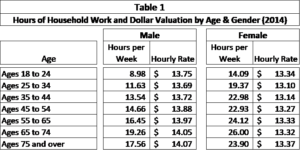 Loss of Household Services Defined
Loss of Household Services Defined
Household services represents a concept that is often difficult to define. If an injured person cannot perform household services for him or herself, the injured person may have to hire someone to perform these tasks either on a temporary or perhaps even a permanent basis, especially if the injured person lives alone. Many forensic accountants define household services as the work done by an individual to maintain a household and includes cleaning, meal preparation and clean-up, yard care, pet care, vehicle maintenance and repair, shopping, obtaining services, travel for household activity, home maintenance and repair, decoration, and renovation. Some accountants also include caring for and helping household children and activities related to the household children’s education and health.
Household services loss calculations are a standard component of damages in economic loss and the courts have long held that the value of household production constitutes a compensable loss in personal injury and wrongful death cases. When a person is injured and goes on to seek compensation for any disabilities caused by the injuries, it may be easy to overlook the need for ongoing household services as part of the personal injury case. But household services should be considered and included in a personal injury case. In addition to a forensic accountant, a vocational expert can help by offering testimony that various household services are jobs and work tasks the plaintiff can no longer perform due to their injuries. Furthermore, medical experts can testify as to the extent of the injuries and how the injured person’s limitations will negatively affect their ability to perform household tasks. The collective testimony of these three expert witnesses can help a jury determine the total loss of household services which should be compensated and should be awarded in light of an injured person’s need for help with day-to-day household services.
Household Services Measurement
There are three approaches to measure household services: the replacement cost method; the market or opportunity cost method; and, the housekeeper method. In the replacement cost approach, the valuation expert considers the cost of hiring individuals to do each activity performed in household work such as food shopping, lawn care, housecleaning, etc. In the market cost approach, there is consideration for the foregone market wage of a person for the time spent doing household production activities. For example, if one person makes $50/hr. in the labor market and it takes that person an hour to mow the lawn, the cost is $50 excluding capital, gas, etc. The so-called housekeeper approach is more straightforward: the cost of hiring a housekeeper to do some or all non-market work. Non-market work covers the goods and services household members produce for their own consumption by combining their unpaid labor and the goods and services they acquire on the market. The value added generated by these activities is excluded. While all methods are used by forensic damages experts, the methods are not equally acceptable.
Replacement Cost / Specialist Cost Method
The replacement cost method requires the financial expert to know what household production activities would have been done “but-for” some event and the local market value of each activity. Special purpose surveys designed and conducted by the expert are expensive and time-consuming and rarely used; instead, the damages expert is likely to rely on time-use studies offered alone or in combination with activity-specific market wages. Time-use surveys are widely-used to identify activities of household work. Differences in the surveys are due to various demographics. The use of time-use studies is discussed in more detail in the subsequent section.
Market / Opportunity Cost Method
Leaving aside how to consider particularly thorny issues like possible commuting costs and tax issues, let’s assume two homes in the same location with nearly identical families and lawn sizes. Again, we’ll use the grass cutting example and assume the husband takes an hour to cut the grass. In one home, the man is a brain surgeon making $400/hr. and the other home the man is a school teacher making $20/hr. In the market approach, the one hour needed to cut the grass “costs” $400 for one person vs. $20 in the second home, a result that may strike some as absurd. Few damages experts actually use the market approach, but it’s good to be prepared on the odd chance you may encounter such an expert in court.
Housekeeper Method
Similarly, the housekeeper approach requires knowledge of market wages for such workers, but a housekeeper usually does not do all the tasks included in a basket of non-market work, so this approach is not as accurate as the replacement cost approach.
Household Services – Replacement Cost Method
When estimating post-injury capacity, consideration is given to the individual’s impairment and functional requirements of the household tasks. The residual capacity is subtracted from the pre-injury estimate to determine the hours that need to be replaced. The analysis assesses the replacement cost needed, stated in terms of current dollars, based on an estimate for the hourly wage of persons performing similar tasks. The estimate of pre-injury hours is based on data from the American Time Use Survey (ATUS) collected from 2003 through 2017. The ATUS, sponsored by the U.S. Bureau of Labor Statistics and conducted by the U.S. Census Bureau, is the largest time survey taken in the United States. The average hours for household services are based on gender and age.
Studies have been performed that measure the value of household services. Information from these studies may be used to estimate the value of household services lost “but for” the injury. A publication, “The Dollar Value of a Day (DVD) by Expectancy Data (2014)” is the primary source of values utilized by forensic accountants who employ the replacement cost methodology, and as such, it provides comprehensive information when valuing household services in cases of total disability or death. This publication relies on the ATUS. The data used to make the wage replacement cost valuation for household services is obtained from the BLS Occupational Employment Statistics survey (OES) that tracks more than 1,000 occupational titles. As a result, DVD provides a market estimate of the cost needed to support or replace time use.
DVD presents 200 tables that show the average weekly hours of activities performed by persons with similar demographics as well as the hourly value of the household services according to proxies available from OES. The tables present many different classifications such as: age, married or unmarried, male or female, working full-time or part-time or unemployed, children of a particular age range in the household, and whether the spouse is employed, among others. Various forensic accountants, economists, rehabilitation counselors, and life care planners differ in their approaches in how they utilize these tables.
Table 1 provides an example of the average hours of household work and hourly valuation by gender and age grouping. The average hours per week spent on household work ranges from 8.98 to 19.26 for males and 14.09 to 26.00 for females. The hourly value of household services based on replacement cost ranges from $13 to $14 per hour.

The Schultz Decision
Some courts have disallowed claims for household services because there was no proof that any household services were performed. A decision by the New York State Court of Appeals has forced forensic damage experts to reconsider the foundation for their household services loss analyses. In Schultz v. Harrison Radiator Division General Motors Corporation, 90 N.Y.2d 311,660 N.Y.S. 2d 685,683 N.E.2d 307 (1997), the court excluded economic testimony concerning an individual’s loss of ability to perform household services. The testimony was excluded since the value of such services did not serve a compensatory function. This case involved an unmarried individual with no dependents, and defense attorneys made the argument that there can be no testimony concerning household services loss in any case unless the plaintiff has actually incurred costs to replace the lost ability to perform household services. Thus, before including damages for lost household services, the forensic damages expert should ensure the services were previously provided by the injured party.
Summary
In light of the Schultz decision, it is useful for the forensic accountant to have a working knowledge of the legal basis for projecting household services loss under varying circumstances. In particular, the spouse’s claim for compensation for lost household services under loss of consortium statutes should be examined and compared with an individual’s claim for impairment of the ability to perform household services for his or her own benefit. An examination of the legal basis for performing household services loss evaluations must also include a review of Statutory law and Case law from various jurisdictions in order to determine whether courts favor specific types of household services loss analyses under specific circumstances.

Comments are closed.